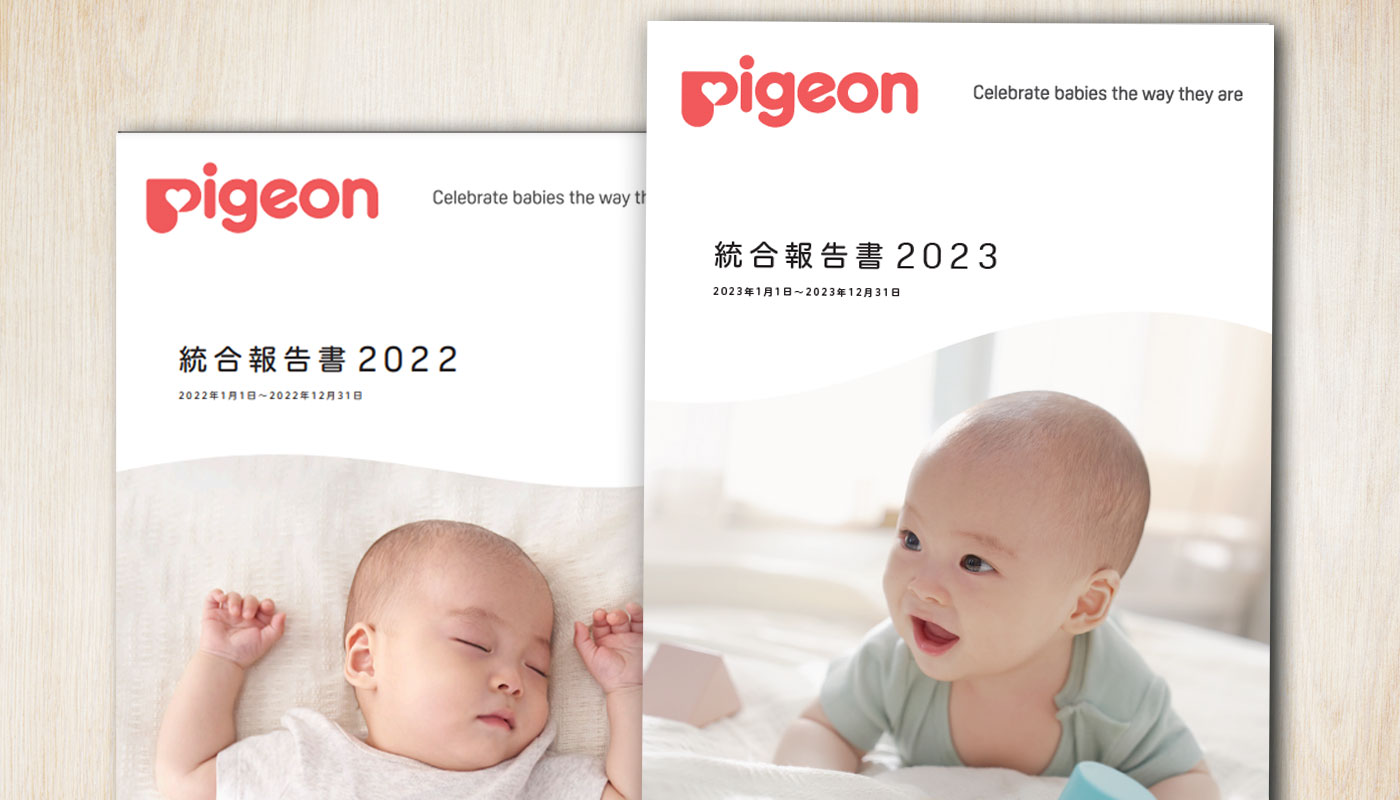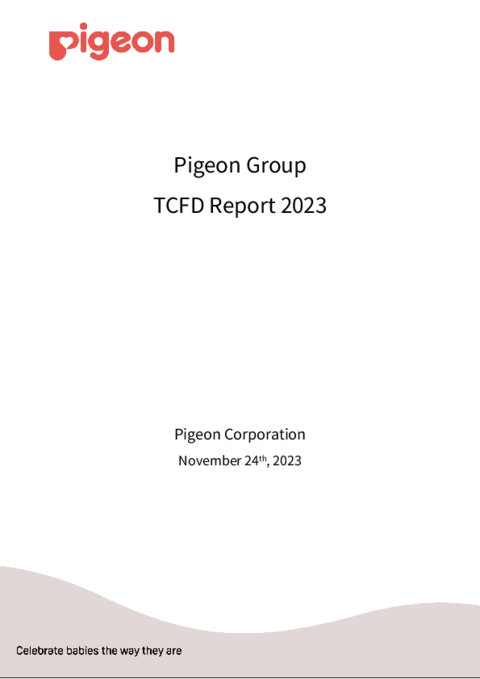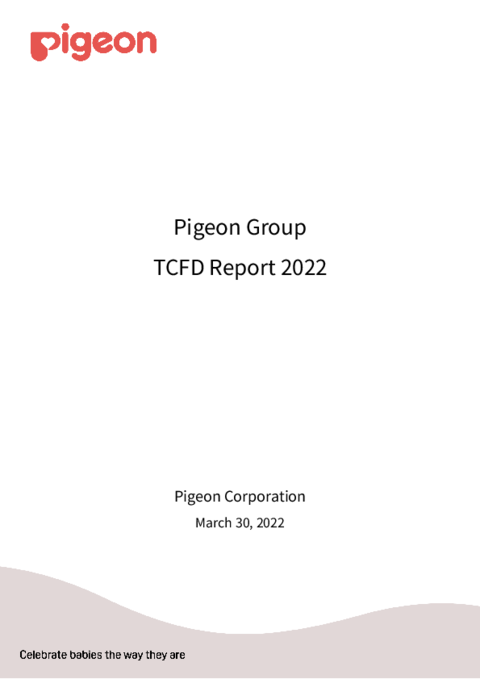By continuing to truly focus upon babies, we want to make the world more baby-friendly.
At the same time, we aim to achieve sustainable growth as a company by reducing environmental impact and solving social issues surrounding babies and families in all countries and regions where we conduct business activities. We particularly recognize the urgency of climate change. Pigeon’s Eighth Medium-Term Business Plan (2023 - 2025) as well as the Seventh Medium-Term Business Plan (2020 - 2021) identifies climate change as one of the most important management challenges and outlines measures to tackle it.
Report in line with the TCFD Recommendations
In 2021, Pigeon publicly declared its support for the recommendations of the Task Force on Climate-Related Financial Disclosures (TCFD). We conducted a financial impact analysis of climate-related risks and opportunities focusing on the Pigeon Group‘s core products - baby bottles and nipples and skincare businesses, and have disclosed the results of the analysis and our strategy together with governance, risk management, targets and metrics regarding climate-related risks and opportunities in the Pigeon Group TCFD Report 2023.
Governance and Risk Management for Climate-Related Risks and Opportunities
Among the climate-related challenges facing our company, some risks have a relatively high probability in the short to medium term and are directly connected to business continuity, such as operation interruptions due to flooding. Management of these risks are centered around the GHO Risk Management Committee.
Challenges that require a more long-term perspective that cuts across multiple businesses are addressed by the Sustainability Committee, which sets medium- and long-term Group targets related to environmental conservation, including climate change, and evaluates progress made toward them.
Both the GHO Risk Management Committee and the Sustainability Committee are chaired by the Director responsible for GHO, and both committees report the results of their deliberations to the Board of Directors.
Among the Pigeon Green Action Plan, the Pigeon Group has set targets to reduce its Scope 1 and 2 GHG emissions by 50% by 2030 compared to 2018 levels and to achieve net zero Scope 1 and 2 GHG emissions by 2050. The achievement of this target is one of the non-financial performance indicators used to calculate the amount of stock remuneration to be paid to directors (excluding independent outside directors) when they step down, which means that the Pigeon Group’s Scope 1 and Scope 2 greenhouse gas emissions reduction performance is reflected in directors' remuneration.
Strategy
1. Climate Scenario Analysis
Because the Pigeon Group provides a wide range of products and services to customers in over 90 countries and regions around the world, our analysis has focused on manufacturing and sales of nursing bottles, nipples, and skincare sold in Japan and China, which account for a relatively significant proportion of sales in those regions.
Two scenarios were used for analysis: one in which the world makes progress toward decarbonization in order to limit average global temperature rise to 1.5℃ above pre-industrial levels by2100 (the “1.5℃ scenario”), and one in which carbon emissions are high and average global temperature reaches 4℃ above pre-industrial levels by2100 (the “4℃ scenario”). The world of 2030 (2050, for physical impacts) under these two scenarios was hypothesized as follows:
| 1.5°C scenario world | 4°C scenario world |
|
|
2. Risks and Opportunities for Our Nursing Bottles, Nipples, and Skincare Business
2-1. Changes in the Consumer Market
Nursing bottles and nipples, which are core products for Pigeon, will continue to be essential parenting products needed by babies regardless of the climate situation or policies. However, because great changes in the climate and environment are expected under the 4°C scenario—such as more common and severe natural disasters—we expect that uncertainty about the future for babies may become a factor in decreasing birth rates, which could affect sales of nursing bottles and nipples.
Under the 1.5°C scenario, consumers’ preference for ethical choices would be expected to grow stronger. This would increase the importance of product strategies focused on both making products with consideration for the environment across the entire value chain and promoting these efforts to consumers.
Under both the 1.5°C and 4°C scenarios, the climate would be expected to change and natural disasters to become more frequent. As a results, demand would be expected to rise for products that address heat, humidity, and dryness, and products that use less water than current products—or no water at all—during interruptions of water service due to drought or flood.
2-2. Policy and Regulatory Changes
The 1.5°C scenario envisages the introduction of strict regulations and policies aimed at decarbonization around the world. One risk envisaged under the 1.5°C scenario is the introduction of carbon pricing mechanisms globally, resulting in the Pigeon Group becoming subject to a carbon tax on either Scope 1 or Scope 1 & 2 GHG emissions, or needing to buy emissions allowances as part of an emissions trading scheme.
Additionally, globally strengthened decarbonization policies can be expected to lead to price increases for electricity, freight rates, raw materials derived from palm oil, and fossil fuel-based plastics and to the introduction of new regulation on plastics use. These are expected to result in increasing manufacturing costs, product development costs, and capital invest in equipment.
2-3. Increased Incidence of Natural Disasters
Under both the 1.5℃ scenario and the 4 ℃ scenario, average global temperatures rising above even their current levels is expected to result in both acute issues, in the form of more frequent and severe extreme weather events and natural hazards, and chronic issues, in the form of changes in climate. For this reason, the probability of supply chain disruption due to floods, droughts, or outbreaks of new communicable diseases is expected to rise, resulting in more frequent interruptions to manufacturing. THAI PIGEON, which manufactures plastic nursing bottles, nipples, caps, and hoods, is located in a low-lying area near the sea with many waterways nearby; accordingly, it is at risk of chronic inundation due to rising sea levels in long-term future.
To address the risk of manufacturing interruptions due to supply chain disruption, we are taking measures such as securing sufficient raw mterials for a specified period on-site, purchasing key materials from two suppliers (dual sourcing), and storing sufficient stocks of finished products, as well as establishing the structure to allow temporarily switching production to our other manufacturing sites.
For information on potential financial impacts on our business of climate-related risks and opportunities, please see the Pigeon Group TCFD Report 2023.
TCFD Report
For details about climate-related governance, strategy, risk management, metrics, and targets, see the Pigeon Group TCFD Report.





